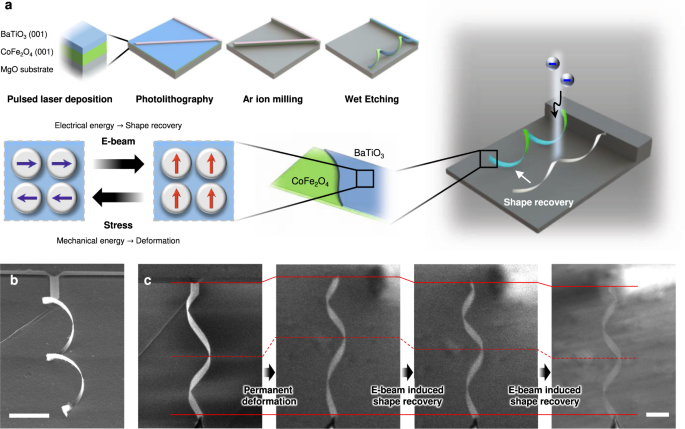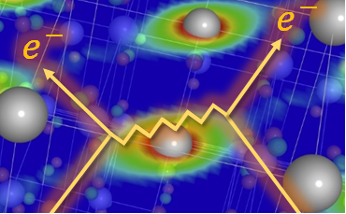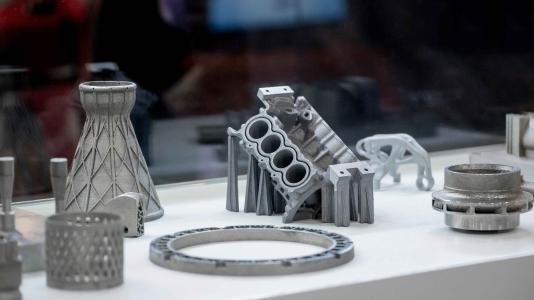チューリッヒ工科大学の研究者らは、わずか数ナノメートルの大きさの物体で初めて形状記憶効果を達成しました。これは、ナノスケールの小さな機械やロボットデバイスの製造に利用できる。 Researchers at ETH Zurich achieved a shape memory effect for the first time with objects that are only a few nanometers in size. This can be used to manufacture tiny machinery and robotic devices on the nanoscale.
2023-03-09 スイス連邦工科大学チューリッヒ校(ETHZurich)
研究チームは、約20ナノメートル厚のフェロイック酸化物製の層に形状記憶効果を示し、これはこれまでに観察された最小のサンプルサイズです。
この効果は、以前は熱または磁気の操作で誘導されていましたが、このセラミック材料は、電子線を使用して効果を誘導することができるため、より広範囲な応用が可能です。
例えば、筋肉繊維や脊椎の一部を置き換えることができる高弾性材料であるため、柔軟性のあるエレクトロニクス、ソフトロボットシステム、ナノロボットなどの分野で使用される可能性があります。また、鉄電酸化物の磁気電気特性を制御することができるため、ヒト体内に埋め込まれたナノロボットが細胞を刺激し、組織を修復するなどの医療アプリケーションにも使用できます。
<関連情報>
- https://ethz.ch/en/news-and-events/eth-news/news/2023/03/shape-memory-for-nano-sized-objects.html
- https://onlinelibrary.wiley.com/doi/10.1002/admt.202202097
- https://www.nature.com/articles/s41467-023-36274-w
ひずみ感応型フレキシブル磁電体セラミックスナノコンポジット Strain-Sensitive Flexible Magnetoelectric Ceramic Nanocomposites
Minsoo Kim, Donghoon Kim, Buse Aktas, Hongsoo Choi, Josep Puigmartí-Luis, Bradley J. Nelson, Salvador Pané, Xiang-Zhong Chen
Advanced Materials Technologies Published: 28 February 2023
DOI:https://doi.org/10.1002/admt.202202097

Abstract
Magnetoelectric (ME) oxide materials can convert magnetic input into electric output and vice versa, making them excellent candidates for advanced sensing, data storage, and communication. However, their application has been limited to rigid devices due to their brittle nature. Here, flexible ME oxide composite (BaTiO3/CoFe2O4) thin film nanostructures with distinct ME coupling coefficients are reported. In contrast to rigid bulk counterparts, these ceramic nanostructures display a flexible behavior after being released from the substrate, and can be transferred onto a stretchable substrate such as polydimethylsiloxane. These ceramic films possess high ME coefficients due to minimized clamping effect and preferred crystalline orientation, and exhibit reversibly tunable ME coupling via mechanical stretching thanks to their large elasticity (>4%). It is believed that the study can open up new avenues for integrating ceramic ME composites into micro-/nanoelectromechanical system and soft robotic devices.
ねじれた強誘電体ナノコンポジットにおける形状記憶効果 Shape-memory effect in twisted ferroic nanocomposites
Donghoon Kim,Minsoo Kim,Steffen Reidt,Hyeon Han,Ali Baghizadeh,Peng Zeng,Hongsoo Choi,Josep Puigmartí-Luis,Morgan Trassin,Bradley J. Nelson,Xiang-Zhong Chen & Salvador Pané
Nature Communications Published:10 February 2023
DOI:https://doi.org/10.1038/s41467-023-36274-w

Abstract
The shape recovery ability of shape-memory alloys vanishes below a critical size (~50 nm), which prevents their practical applications at the nanoscale. In contrast, ferroic materials, even when scaled down to dimensions of a few nanometers, exhibit actuation strain through domain switching, though the generated strain is modest (~1%). Here, we develop freestanding twisted architectures of nanoscale ferroic oxides showing shape-memory effect with a giant recoverable strain (>8%). The twisted geometrical design amplifies the strain generated during ferroelectric domain switching, which cannot be achieved in bulk ceramics or substrate-bonded thin films. The twisted ferroic nanocomposites allow us to overcome the size limitations in traditional shape-memory alloys and open new avenues in engineering large-stroke shape-memory materials for small-scale actuating devices such as nanorobots and artificial muscle fibrils.



